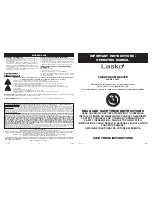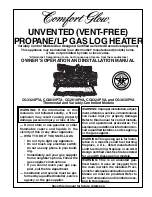
IO-123163 Effective 01-14-2016
11
15. Adjustment of Heat Anticipator
After all connections are made, start-up and checkout must be
performed before proper evaluation of the entire system can be
made. Make sure that heat anticipator is properly set as noted
on thermostat instructions. Load requirements can vary in each
residence and it may be necessary for the installer or homeowner
to make slight adjustments to the heat anticipator setting for longer
or shorter cycles. It is recommended to change the setting no more
than plus or minus 0.05 amps at a time. Greater changes can cause
the unit to rapid cycle or remain on excessively.
7.
Check the pump to ensure proper operation. The water inlet of the
unit should be hot if the water temperature in the water heater has
reached the set point. If water is not being circulated through the coil
but the pump is running, then open the air bleed valve in the unit and
purge any air left in the system.
8.
Adjust the water heater thermostat so that the water temperature
entering the hot water coils is 120 – 180ºF depending on the amount
of heat required by the structure. This is done with the unit energized
and operating long enough for all temperatures to stabilize.
After all connections are made, start-up and check-out must be
performed before proper evaluation of the entire system can be
made. Make sure that heat anticipator is properly set as noted on
thermostat instructions.
Load requirements can vary in each residence and it may be
necessary for the installer or homeowner to make slight adjustments
to the heat anticipator setting for longer or shorter cycles. It is
recommended to change the setting no more than plus or minus 0.05
amps at a time. Greater changes can cause the unit to rapid cycle
or remain on excessively. To properly check the unit’s operation,
the installer should have an electrical current measuring device
(0-10 amp Amprobe, Fluke), air pressure measuring device (0-1.0
in slope gauge), and a temperature-measuring device (0-200ºF
thermometer).
Install the Amprobe to measure blower current, the slope gauge to
measure static air pressure at the units and the temperature device
to measure unit supply and return air temperature. Before taking
measurements, be sure that all registers, grilles and dampers are
open or are set to their proper positions. Be sure that clean filters
are in place. Temperature measuring device must be installed
to obtain average temperature at both inlet and outlet. For outlet,
measure temperature of each main trunk at a location far enough
away to avoid heater radiation and read the average temperatures.
Table 16-1 below shows the CFM that should be achieved at various
external static pressures.
Purging The System
1.
Open air vent and allow water heater to fill with water. Close air
vent when water heater is full and all air has been purged.
2.
Ignite water heater. Set thermostat on water heater to 140 degrees.
3.
Close the valve on the hot water supply from the water heater (“A”)
and open the valve on the cold water return to the water heater (“B”).
Then open the air vent in the fan coil. Use bucket or hose to discard
water during purging process at air bleed valve. Purge air completely
from line.
4.
Once air is purged, close return valve (“B”) and open supply valve
(“A”). Purge the coil and lines of air completely.
5.
After air is purged from the system and filled with water, open the
return valve (“B”). Then close the air vent in the fan coil.
6.
Apply power to the fan coil and set the room thermostat on heat.
Raise the temperature setting to activate the circulating pump
16. Start-Up
The hot water (hydronic) coil and all
water lines MUST be purged of air
prior to starting the pump. Failure to
do so could result in pump damage. Aspen will not be
responsible for any property or personnel damage caused
by failure to follow this instruction.
!
WARNING
Hot water flowing to the coil should be
in the range of 120º - 180º F. Water at
these temperatures can cause first-
degree burns. Use of proper safety gear while installing
or servicing the equipment is strongly recommended
as is installation of a water-tempering valve (for
water temperatures of above 140ºF) to supply lower
temperature water to fixtures in the house. N170L series
or equivalent should be used.
!
WARNING
Connect the hydronic coil to the water heater system as shown in Fig
16-1 and 16-2. Use flexible piping and insulate all pipes. Plumbing
must be in compliance with state or local codes (Code CMR248
in Massachusetts). The units for hydronic heat have different top
and heater box configurations. This configuration is not suitable
for electric heat. DO NOT try to install hydronic heater in a unit not
equipped for it. Verify connections: hot water to “in” and cold water
to “out”. 7/8” OD stubs are provided for plumbing connections. Bleed
the air flow system through the bleeder port or optional valve.
Fig. 16-1
Fig. 16-2


































